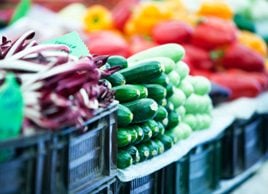5 habits for eco-friendly food shopping
Want to make your grocery shops greener? Keep the following practices in mind when planning menus, shopping for food and dining out

If you have a good farmers’ market or a conscientious food co-op that sells meat and seafood as well as produce, then most of the work is done for you. If you have to search farther afield for what you need, however, these simple guidelines will help to keep you on the straight and narrow in your goal to buy eco-friendly foods.
1. Shop local
Buying from local farmers helps to support the preservation of small farms and undeveloped land. And not only does local food taste better and have higher nutritional value because of its freshness, but you know exactly what you’re getting‘unlike with products from far away, where details about pesticides, land use, and working conditions are hard to come by. In contrast, local farms are transparent places where people are usually welcome to buy goods or take tours. Look for locally made goods at the supermarket, too: Some stores are making an effort to highlight local providers, even giving them their own section. Let shopkeepers know what you want by spending your dollars on local goods.
2. Buy organic foods
It’s common to see organic foods at the supermarket, but don’t rely on the label alone. The organic food label is quite controversial these days. Organic food is grown without pesticides, but it can have other environmental drawbacks. Food labeled ‘organic’ often comes from large farming operations that devastate the earth where it’s grown; is flown in from thousands of miles away, creating more carbon emissions; and is processed to stay preserved during transport. The organic label can help you navigate your way around a conventional grocery store, but it’s worth investigating the organic brands that you like and checking out their environmental record.
3. Serve seasonal produce
Try to eliminate out-of-season produce, such as asparagus and strawberries in winter that must be brought in from far away. Reducing air and ground transport for food cuts our use of fossil fuels and alleviates air pollution. And if you’re looking to save money, seasonal foods are the cheapest choice: walk through the farmer’s market at closing time to find deals from farmers who would rather unload ripe items than take them back.
4. Choose eco-friendly fish
Consult online seafood guides when planning a menu. Do some research to discover which species are being fished or farmed using conscientious practices. Make a list and bring it with you to the market, so you know what to look for at the seafood counter or in the frozen seafood section. And remember, you can always buy canned or jarred sardines or anchovies’safe choices every time.
5. Eat less meat and buy responsibly
Animals raised for slaughter in a free-range manner put less wear and tear on the ground where they’re raised and require fewer or no antibiotics. Animal waste that’s free of antibiotics and chemicals is friendlier to groundwater, plants, rivers, and wildlife. Because of the methane from their manure and the energy needed to grow and transport their feed, the world’s livestock accounts for 18 percent of greenhouse gases, more than all forms of transportation combined (New York Times, October 9, 2008). Two to five times more grain is required to produce the same amount of calories from meat as from eating the grain itself. Buying meat from small farmers with sustainable business practices and reducing your meat intake can significantly help the environment.
Excerpted from Lucid Food by Louisa Shafia Copyright © 2009 by Louisa Shafia. Excerpted by permission of Ten Speed Press, a division of Random House of Canada Limited. All rights reserved. No part of this excerpt may be reproduced or reprinted without permission in writing from the publisher.




